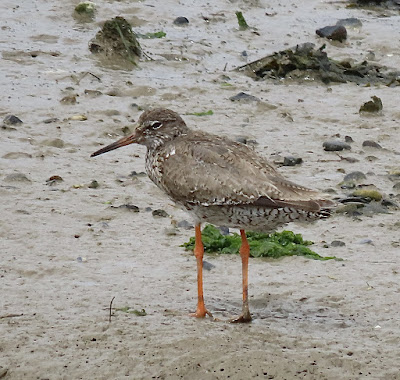On Saturday 12th a little egret perched on a bush near the East Mersea Oyster Fishery. At Reeveshall two green sandpipers and a greenshank were on the pool, ten stock doves in the field, while two sand martins were flying with fifty swallows over the fields. Near the Oyster Fishery were a willow warbler, Cetti's warbler, sedge warbler and two whitethroats, while two willow warblers were in Fishponds Wood.
Two ospreys were seen distantly perched on two posts on the Geedons, two marsh harriers were on Langenhoe and two buzzards flying over Fishponds Wood calling. In the Pyefleet were three Sandwich terns, three common terns, 3 avocets, 16 golden plover, 18 black-tailed godwits and six dunlin.
There was no sign on Saturday of the male Lesser Emperor dragonfly near the dyke at the Oyster Fishery, which had been seen here by Chris Poole the day before. A first sighting for the Island. Chris also saw brown hawker, five southern migrant hawkers, emperor dragonfly, common darter and ruddy darter during his walk on Friday between the Golfhouse and Shop Lane.
A redshank was feeding on the mud behind the Dabchicks sailing club on Friday 11th. On the opposite side of the channel from the Dabchicks were most of the 100 black-tailed godwits seen during a walk along the Strood seawall. Other waders of interest along the Strood at low tide were two greenshank, four golden plover and eight grey plover. A buzzard perched on a telegraph post, two yellow wagtails, ten linnets, whitethroat and a willow warbler were seen, while 38 swifts flew over houses near Firs Road. Adrian Amos reported three swifts over his East Road house on Friday afternoon.
A green sandpiper was heard calling as it flew over the Firs Chase garden, whilst I checked the moth trap at 01.30 in the early hours.
An osprey flew down the Strood channel being mobbed by gulls on Thursday 10th. Possibly one of the Colne birds, it carried on flying over Copt Hall then headed down Salcott Channel and lost to view.
A buzzard flew over the Strood seawall on Thursday, also two marsh harriers and three kestrels seen out hunting over the fields. The whinchat was seen flying from the outside of the seawall and then landing on the Strood sluice railing briefly, before flying back over the seawall. A meadow pipit flying over was the first one here since the spring, two yellow wagtails and 20 linnets were feeding in the fields. Two willow warblers were along the dyke, two in Feldy View and another two were in Firs Chase. Fifteen swifts were flying over West Mersea.
There was a big increase in the number of redshanks in the Strood Channel seen on Thursday with at least 400 birds counted. Also two greenshank, 90 black-tailed godwits, 97 curlew, two whimbrel, five grey plover, five lapwing and also 25 Mediterranean gulls.
Michael Thorley photographed this migrant hawker in his East Mersea garden on Wednesday 9th - here in close-up.
As well as the migrant hawker in Michael's garden, there were a brimstone, red admiral, gatekeeper and comma butterflies seen.
Along the Strood channel on Wednesday was this greenshank feeding along the water's edge, also 15 grey plover, 100 black-tailed godwits, 150 redshank, 20 curlew, two Mediterranean gulls and two common terns.
A hobby was flying high over the East Mersea road near the Strood, a marsh harrier flew over Ray Island, four buzzards circled together over the Peldon fields while three kestrels hunted over the Strood fields.
The whinchat was still present along the Strood dyke on Wednesday, spending most of its time resting in a clump of dead Alexanders. Five willow warblers were seen during the walk with two along the dyke, two in Feldy View and one in the Firs Chase garden. Three sedge warblers, two reed warblers and two yellow wagtails were along the dyke.
Shaun Bater walked the Strood seawall on Wednesday morning and noted 15 black-tailed godwits, 35 curlew, six common terns, ten grey plover, grey heron, three kestrels, greenfinch, 25 linnets, six little egrets, 100 redshank, two reed buntings, reed warbler, ten swallows, two sedge warblers, whitethroat, willow warbler, whimbrel and four yellow wagtails.
Later on Wednesday afternoon the whinchat and2 yellow wagtail, 25 linnets, skylark and two greenfinches were seen along the Strood by Steve Entwistle.
A brown argus visited the Firs Chase garden on Wednesday - the first visit this summer. Other butterflies in the garden in recent days have been gatekeeper, holly blue, small white, peacock, red admiral and comma.
Adrian Amos thinks this is his best summer for insects in his East Road garden despite the mixed weather. On Wednesday he reported two red admirals, three commas, six holly blues, 25 meadow brown / gatekeepers, lots of grasshoppers in his grassland as well as lots of hoverflies and bumble-bees and two possible rose chafers.














No comments:
Post a Comment